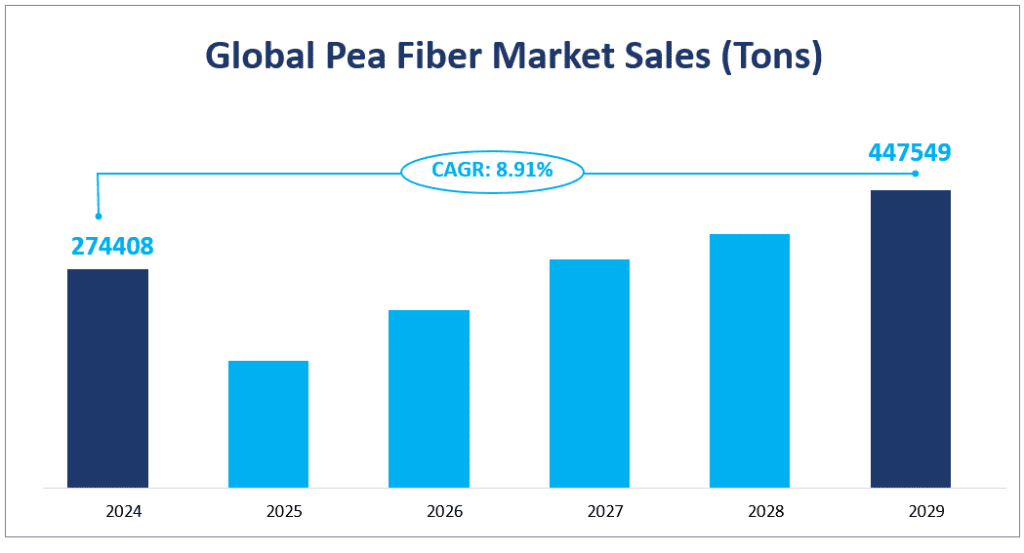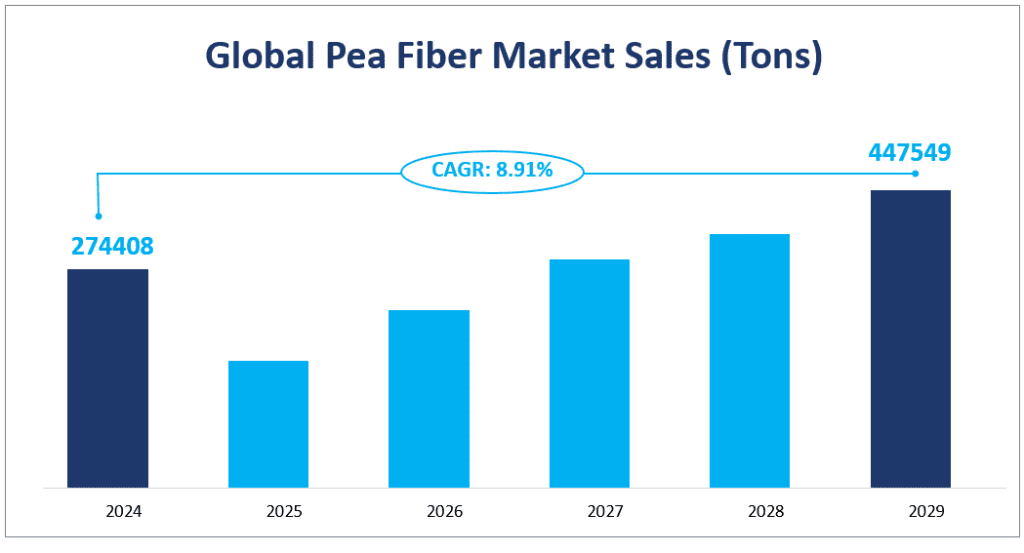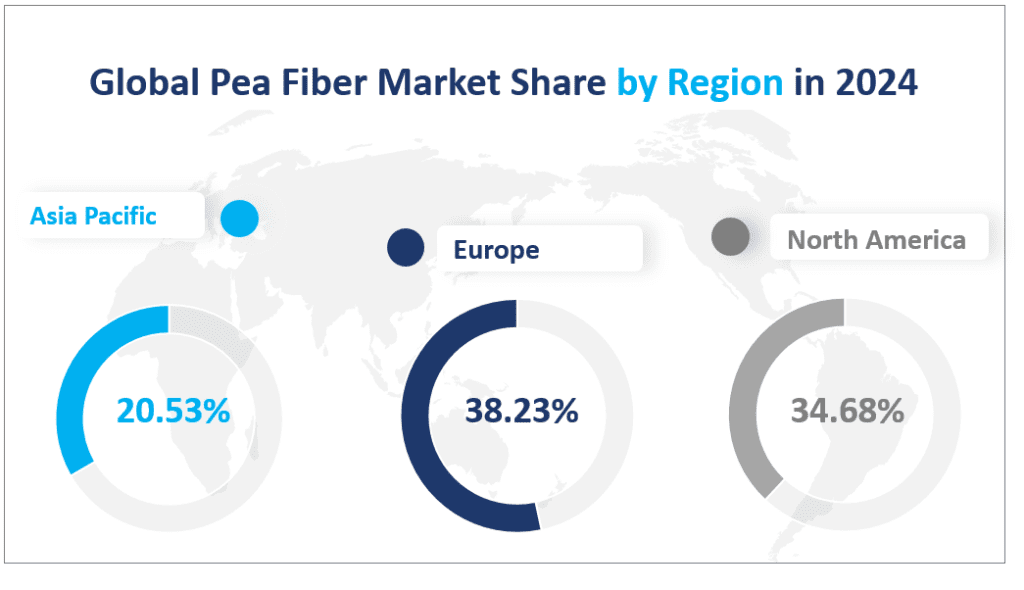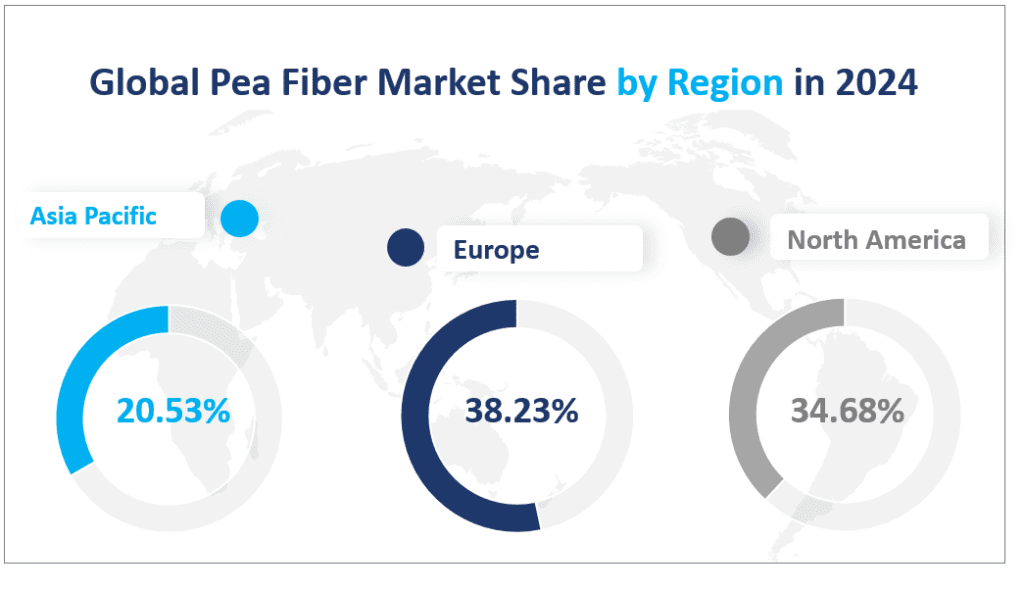1. Global Pea Fiber Market Overview and Growth Analysis
The global pea fiber market is projected to experience significant growth in the coming years, with 2024 being a pivotal year for market expansion. The sales volume in 2024 is anticipated to reach 274408 Tons, with a CAGR of 8.91% from 2024 to 2029.
Pea fiber, extracted from the outer layer of peas, is a natural dietary fiber that offers a range of health benefits and functional properties. It is highly absorbent, low in carbohydrates, and promotes the growth of healthy intestinal bacteria, thus regulating digestion. Pea fiber is derived from specially cleaned and processed pea shells, and it is recognized for its superior water-binding capacity and low energy content, making it an excellent ingredient for promoting satiety in low-energy diets. The fiber is also allergen, cholesterol, lactose, and gluten-free, providing many functional and nutritional benefits, including fat and caloric reduction in the final product.
Pea fiber is increasingly used in various food applications, such as bakery products, meat products, soups & sauces, nutritional products, and animal foods, due to its versatility and health benefits.
Global Pea Fiber Market Sales (Tons)


2. Driving Factors of Pea Fiber Market Growth
Health and Nutritional Benefits: Pea fiber’s ability to aid digestion, control blood sugar levels, lower cholesterol, and support overall gut health has made it a popular choice for health-conscious consumers.
Rising Demand for Plant-Based Ingredients: With the increasing trend towards plant-based diets and products, pea fiber, as a vegan and vegetarian-friendly option, is gaining traction in the food industry.
Innovations in Food Technology: Advances in food technology have led to the development of new product lines that incorporate pea fiber, expanding its applications beyond traditional uses.
Consumer Preference for Natural and Additive-Free Foods: There is a growing consumer preference for natural, non-GMO, organic, and additive-free products, which aligns with the attributes of pea fiber.
Market Expansion in Emerging Economies: The developing markets, with their growing middle class and increasing demand for healthy food options, present new opportunities for the pea fiber market.
3. Limiting Factors of Pea Fiber Market
Raw Material Price Fluctuations: The primary raw material, peas, is subject to weather and market conditions, leading to unpredictable price fluctuations that can impact profitability.
Brand Barriers: Established brands with long-standing reputations and customer loyalty pose a challenge for new entrants in the market.
Threat of Substitutes: The presence of alternative plant fibers, such as potato and corn fiber, can limit the growth of the pea fiber market as they are also considered high-quality fiber sources.
Seasonality and Inventory Management: The strong seasonality in the purchase of agricultural products like peas requires significant inventory management, which can affect business costs and market stability.
Regulatory Policies: Stricter policies in various regions can hinder market growth, as they may increase the cost of production and compliance.
4. Global Pea Fiber Market Segment
The global pea fiber market is segmented into two primary product types: Organic Pea Fiber and Normal Pea Fiber. Each type caters to different market demands and has distinct characteristics that influence their sales and growth rates.
Organic Pea Fiber: Organic pea fiber is derived from peas grown without the use of synthetic fertilizers, pesticides, or genetically modified organisms (GMOs). This type of fiber is particularly appealing to health-conscious consumers who prefer natural and environmentally sustainable products. In terms of market sales, Organic Pea Fiber is projected to dominate the global pea fiber market in 2024. With a significant market share and a strong growth rate, this product type is expected to reach sales of 244207 tons in 2024, reflecting a compounded annual growth rate that outpaces other types.
Normal Pea Fiber: Normal pea fiber, also known as conventional pea fiber, is derived from peas grown using standard agricultural practices that may include the use of synthetic fertilizers and pesticides. This type of fiber is more cost-effective to produce but may not appeal to consumers seeking organic or natural products. Despite this, normal pea fiber still holds a substantial market share due to its broader acceptance and lower price point.
Organic Pea Fiber has the largest market share and the fastest-growing rate among the two product types. This is attributed to the increasing global trend towards health and wellness, with consumers showing a preference for organic products. The market share for Organic Pea Fiber is expected to be significantly higher than that of Normal Pea Fiber, with a sales volume that is over eight times greater in 2024.
The global pea fiber market is diverse in its applications, with the product being utilized across various industries. The main applications include Bakery Products, Meat Products, Soups & Sauces, Nutritional Products, Animal Foods, and Others.
Bakery Products: Pea fiber is used in bakery products for its ability to enhance texture, increase nutritional value, and improve the overall quality of the final product. In 2024, the bakery products application is expected to have the largest market share, with sales projected to reach 58,393 tons. The growth rate for this application is also significant, driven by the increasing demand for health-oriented bakery products that contain added dietary fiber.
Meat Products: In the meat products industry, pea fiber is used as a binder and texturizer, providing a meat-like texture to plant-based alternatives. The market sales for meat products application are expected to be 77,368 tons in 2024, with a strong growth rate due to the rising popularity of plant-based meats.
Soups & Sauces: Pea fiber adds thickness and stability to soups and sauces without affecting the flavor profile. This application is expected to have market sales of 36,989 tons in 2024, with a steady growth rate as consumers seek out healthier and more natural food products.
Nutritional Products: Nutritional products, including dietary supplements and fortified foods, benefit from the high fiber content of pea fiber. With sales projected at 43,405 tons in 2024, this application has a substantial market share and a growing rate as the health and wellness trend continues to gain momentum.
Animal Foods: Pea fiber is also used in animal foods for its nutritional benefits and digestibility. The market sales for this application are expected to be 35,593 tons in 2024, with a consistent growth rate due to the ongoing demand for high-quality pet food ingredients.
Among all applications, Nutritional Products stand out with the fastest-growing rate. This is attributed to the increasing awareness of the importance of dietary fiber in maintaining a healthy diet, coupled with the growing trend of fortifying food products with additional health benefits.
Market Sales and Share by Segment
| Market Sales (Tons) in 2024 | Market Share in 2024 | ||
| By Type | Organic Pea Fiber | 244207 | 88.99% |
| Normal Pea Fiber | 30200 | 11.01% | |
| By Application | Bakery Products | 58393 | 21.28% |
| Meat Products | 77368 | 28.19% | |
| Soups & Sauces | 36989 | 13.48% | |
| Nutritional Products | 43405 | 15.82% | |
| Animal Foods | 35593 | 12.97% |
5. Pea Fiber Regional Market Analysis for 2024
North America is anticipated to be the largest regional market for pea fiber in 2024, with sales projected to reach 95,167 tons. This region’s dominance can be attributed to the growing health consciousness among consumers, the presence of key manufacturers, and the increasing demand for plant-based protein sources in the food industry.
Europe follows closely with an expected market share of 104,899 tons. The region’s strong performance is driven by health-focused dietary trends, the presence of established manufacturers, and a robust agricultural sector that supports the production of peas.
The Asia-Pacific region is expected to show significant growth, with sales projected at 56,338 tons. The growth in this region is fueled by the expanding middle class, increasing health and wellness trends, and the rising demand for organic and natural food products.
Latin America the Middle East and Africa are also projected to contribute to the global market, with sales of 10,115 tons and 7,889 tons, respectively. These regions are experiencing growth due to increasing awareness of the health benefits of pea fiber and the gradual adoption of plant-based diets. Among these regions, the Asia-Pacific region is expected to be the fastest-growing, with a significant increase in market share due to the burgeoning health food market and the increasing demand for high-fiber ingredients in dietary products. The region’s growth is also supported by the expanding food and beverage industry and the rising preference for organic and natural ingredients.
The global pea fiber market is set to expand in 2024, with North America leading in sales volume and the Asia-Pacific region showing the fastest growth. These trends reflect the global shift towards health-conscious consumer behavior and the increasing adoption of plant-based ingredients in the food industry. As the market continues to evolve, it will be crucial for manufacturers to cater to regional preferences and leverage the unique opportunities presented by each region.
Global Pea Fiber Market Share by Region in 2024


6. Analysis of the Top Five Companies in the Pea Fiber Market
Company Introduction and Business Overview: Roquette is a global leader in plant-based ingredients, with a focus on pea proteins and pharmaceutical excipients. Established in 1933, Roquette operates manufacturing bases primarily in Europe and the Americas, serving customers worldwide.
Products Offered Roquette offers a range of pea fiber products, including PEA FIBER I 50M, which is used in pet food and feed specialties for fiber enrichment and texturizing.
Company Introduction and Business Overview: Shuangta Food, established in 1992, is a Chinese company specializing in the production of pea protein, pea starch, and pea fiber. The company’s sales regions are mainly in Asia and North America.
Products Offered: Shuangta Food offers pea fiber as a dietary fiber product, which is used in various food applications, including spices, pastry fillings, and meatball stuffing.
Company Introduction and Business Overview: Cosucra, established in 1852, is a Belgian company that manufactures and distributes natural food ingredients sourced from chicory and peas. The company’s products are marketed under various brands and are available worldwide.
Products Offered: Cosucra offers pea fiber products like SWELITE™ C pea fiber, which is used in restructured products and processed poultry products due to its high water holding capacity.
Company Introduction and Business Overview: Emsland Group, founded in 1928, is a German company and a leading manufacturer of potato starch and pea-based food ingredients. The company operates mainly in Europe, Asia, and the Americas.
Products Offered: Emsland Group provides pea fiber products that are used for their high water binding capacity, oil absorption capacity, and texture improvement in various food applications.
Company Introduction and Business Overview: NutriPea, established in 1978, is a Canadian company dedicated to manufacturing pea protein from yellow peas. The company has a long-standing reputation for providing a consistent and stable supply of pea protein globally.
Products Offered: NutriPea offers pea fiber products like Centara™ Pea Hull Fiber and Uptake 80™ Pea Cell Wall Fiber, which are used for dietary fiber enrichment and texture improvement in various food applications.
Major Players
| Company Name | Manufacturing Bases | Sales Regions |
| Roquette | Mainly in Europe and the Americas | Worldwide |
| Shuangta Food | China | Mainly in Asia and North America |
| Cosucra | Mainly in Europe | Worldwide |
| Emsland Group | Mainly in Europe | Mainly in Europe, Asia, and the Americas |
| NutriPea | Canada | Mainly in North America |
| PURIS | USA | Mainly in North America |
| AGT Food and Ingredients | Mainly in North America, APAC, Middle East and Africa | Worldwide |
| Vestkorn | Norway | Mainly in Europe |
| Yantai Oriental Protein Tech | China | Mainly in Asia and North America |
| Belle Pulses | Canada | Mainly in North America |
| A&B Ingredients | Mainly in North America | Mainly in North America |
| Shandong Jianyuan Bioengineering | China | Mainly in Asia, Europe, and the Americas |
1 Pea Fiber Market Overview
1.1 Pea Fiber Product Overview
1.2 Pea Fiber Market Segment by Type
1.2.1 Organic Pea Fiber
1.2.2 Normal Pea Fiber
1.3 Global Pea Fiber Market Size by Type
1.3.1 Global Pea Fiber Market Size Overview by Type (2016-2027)
1.3.2 Global Pea Fiber Historic Market Size Review by Type (2016-2021)
1.3.3 Global Pea Fiber Market Size Forecast by Type (2021-2027)
1.4 Key Regions Market Size Segment by Type
1.4.1 North America Pea Fiber Sales Breakdown by Type (2016-2021)
1.4.2 Europe Pea Fiber Sales Breakdown by Type (2016-2021)
1.4.3 Asia-Pacific Pea Fiber Sales Breakdown by Type (2016-2021)
1.4.4 Latin America Pea Fiber Sales Breakdown by Type (2016-2021)
1.4.5 Middle East and Africa Pea Fiber Sales Breakdown by Type (2016-2021)
2 Global Pea Fiber Market Competition by Company
2.1 Global Top Players by Pea Fiber Sales (2016-2021)
2.2 Global Top Players by Pea Fiber Revenue (2016-2021)
2.3 Global Top Players by Pea Fibe Price (2016-2021)
2.4 Global Top Manufacturers Pea Fiber Manufacturing Base Distribution and Headquarters
2.5 Pea Fiber Market Competitive Situation and Trends
2.5.1 Pea Fiber Market Concentration Rate (2016-2021)
2.5.2 Global 5 and 10 Largest Manufacturers by Pea Fiber Sales and Revenue in 2020
2.6 Global Top Manufacturers by Company Type (Tier 1, Tier 2, and Tier 3) (based on the Revenue in Pea Fiber as of 2020)
2.7 Established Date of Key Manufacturers
2.8 Global Pea Fiber Sales Area by Players
2.9 Mergers & Acquisitions, Expansion
3 Pea Fiber Status and Outlook by Region (2016-2027)
3.1 Global Pea Fiber Market Size and CAGR by Region: 2016 VS 2021 VS 2027
3.2 Global Pea Fiber Historic Market Size by Region
3.2.1 Global Pea Fiber Sales in Volume by Region (2016-2021)
3.2.2 Global Pea Fiber Value by Region (2016-2021)
3.2.3 Global Pea Fiber Volume, Value, Price and Gross Margin (2016-2021)
3.3 Global Pea Fiber Forecasted Market Size by Region
3.3.1 Global Pea Fiber Sales in Volume by Region (2021-2027)
3.3.2 Global Pea Fiber Value by Region (2021-2027)
3.3.3 Global Pea Fiber Volume, Value, Price and Gross Margin (2021-2027)
4 Global Pea Fiber by Application
4.1 Pea Fiber Market Segment by Application
4.1.1 Bakery Products
4.1.2 Meat Products
4.1.3 Soups & Sauces
4.1.4 Nutritional Products
4.1.5 Animal Foods
4.2 Global Pea Fiber Market Size by Application
4.2.1 Global Pea Fiber Market Size Overview by Application (2016-2027)
4.2.2 Global Pea Fiber Historic Market Size Review by Application (2016-2021)
4.2.3 Global Pea Fiber Market Size Forecast by Application (2021-2027)
4.3 Key Regions Market Size Segment by Application (2016-2021)
4.3.1 North America Pea Fiber Sales Breakdown by Application (2016-2021)
4.3.2 Europe Pea Fiber Sales Breakdown by Application (2016-2021)
4.3.3 Asia-Pacific Pea Fiber Sales Breakdown by Application (2016-2021)
4.3.4 Latin America Pea Fiber Sales Breakdown by Application (2016-2021)
4.3.5 Middle East and Africa Pea Fiber Sales Breakdown by Application (2016-2021)
5 North America Pea Fiber by Country
5.1 North America Pea Fiber Market Size Market Share by Country (2016-2021)
5.1.1 North America Pea Fiber Sales Market Share by Country (2016-2021)
5.1.2 North America Pea Fiber Revenue Market Share by Country (2016-2021)
5.2 North America Pea Fiber Market Size Market Share by Country (2021-2027)
5.2.1 North America Pea Fiber Sales Market Share by Country (2021-2027)
5.2.2 North America Pea Fiber Revenue Market Share by Country (2021-2027)
6 Europe Pea Fiber by Country
6.1 Europe Pea Fiber Market Size Market Share by Country (2016-2021)
6.1.1 Europe Pea Fiber Sales Market Share by Country (2016-2021)
6.1.2 Europe Pea Fiber Revenue Market Share by Country (2016-2021)
6.2 Europe Pea Fiber Market Size Market Share by Country (2021-2027)
6.2.1 Europe Pea Fiber Sales Market Share by Country (2021-2027)
6.2.2 Europe Pea Fiber Revenue Market Share by Country (2021-2027)
7 Asia-Pacific Pea Fiber by Country
7.1 Asia-Pacific Pea Fiber Market Size Market Share by Country (2016-2021)
7.1.1 Asia-Pacific Pea Fiber Sales Market Share by Country (2016-2021)
7.1.2 Asia-Pacific Pea Fiber Revenue Market Share by Country (2016-2021)
7.2 Asia-Pacific Pea Fiber Market Size Market Share by Country (2021-2027)
7.2.1 Asia-Pacific Pea Fiber Sales Market Share by Country (2021-2027)
7.2.2 Asia-Pacific Pea Fiber Revenue Market Share by Country (2021-2027)
8 Latin America Pea Fiber by Country
8.1 Latin America Pea Fiber Market Size Market Share by Country (2016-2021)
8.1.1 Latin America Pea Fiber Sales Market Share by Country (2016-2021)
8.1.2 Latin America Pea Fiber Revenue Market Share by Country (2016-2021)
8.2 Latin America Pea Fiber Market Size Market Share by Country (2021-2027)
8.2.1 Latin America Pea Fiber Sales Market Share by Country (2021-2027)
8.2.2 Latin America Pea Fiber Revenue Market Share by Country (2021-2027)
9 Middle East and Africa Pea Fiber by Country
9.1 Middle East and Africa Pea Fiber Market Size Market Share by Country (2016-2021)
9.1.1 Middle East and Africa Pea Fiber Sales Market Share by Country (2016-2021)
9.1.2 Middle East and Africa Pea Fiber Revenue Market Share by Country (2016-2021)
9.2 Middle East and Africa Pea Fiber Market Size Market Share by Country (2021-2027)
9.2.1 Middle East and Africa Pea Fiber Sales Market Share by Country (2021-2027)
9.2.2 Middle East and Africa Pea Fiber Revenue Market Share by Country (2021-2027)
10 Company Profiles and Key Figures in Pea Fiber Business
10.1 Roquette
10.1.1 Roquette Corporation Information
10.1.2 Roquette Pea Fiber Products Offered
10.1.3 Roquette Pea Fiber Sales, Revenue and Gross Margin (2016-2021)
10.1.4 Roquette Pea Fiber Relevant Development
10.2 Shuangta Food
10.2.1 Shuangta Food Corporation Information
10.2.2 Shuangta Food Pea Fiber Products Offered
10.2.3 Shuangta Food Pea Fiber Sales, Revenue and Gross Margin (2016-2021)
10.3 Cosucra
10.3.1 Cosucra Corporation Information
10.3.2 Cosucra Pea Fiber Products Offered
10.3.3 Cosucra Pea Fiber Sales, Revenue and Gross Margin (2016-2021)
10.3.4 Cosucra Pea Fiber Relevant Development
10.4 Emsland Group
10.4.1 Emsland Group Corporation Information
10.4.2 Emsland Group Pea Fiber Products Offered
10.4.3 Emsland Group Pea Fiber Sales, Revenue and Gross Margin (2016-2021)
10.4.4 Emsland Group Pea Fiber Relevant Development
10.5 NutriPea
10.5.1 NutriPea Corporation Information
10.5.2 NutriPea Pea Fiber Products Offered
10.5.3 NutriPea Pea Fiber Sales, Revenue and Gross Margin (2016-2021)
10.6 PURIS
10.6.1 PURIS Corporation Information
10.6.2 PURIS Pea Fiber Products Offered
10.6.3 PURIS Pea Fiber Sales, Revenue and Gross Margin (2016-2021)
10.7 AGT Food and Ingredients
10.7.1 AGT Food and Ingredients Corporation Information
10.7.2 AGT Food and Ingredients Pea Fiber Products Offered
10.7.3 AGT Food and Ingredients Pea Fiber Sales, Revenue, and Gross Margin (2016-2021)
10.8 Vestkorn
10.8.1 Vestkorn Corporation Information
10.8.2 Vestkorn Pea Fiber Products Offered
10.8.3 Vestkorn Pea Fiber Sales, Revenue and Gross Margin (2016-2021)
10.9 Yantai Oriental Protein Tech
10.9.1 Yantai Oriental Protein Tech Corporation Information
10.9.2 Yantai Oriental Protein Tech Pea Fiber Products Offered
10.9.3 Yantai Oriental Protein Tech Pea Fiber Sales, Revenue and Gross Margin (2016-2021)
10.10 Belle Pulses
10.10.1 Belle Pulses Corporation Information
10.10.2 Belle Pulses Pea Fiber Products Offered
10.10.3 Belle Pulses Pea Fiber Sales, Revenue and Gross Margin (2016-2021)
10.11 A&B Ingredients
10.11.1 A&B Ingredients Corporation Information
10.11.2 A&B Ingredients Pea Fiber Products Offered
10.11.3 A&B Ingredients Pea Fiber Sales, Revenue and Gross Margin (2016-2021)
10.12 Shandong Jianyuan Bioengineering
10.12.1 Shandong Jianyuan Bioengineering Corporation Information
10.12.2 Shandong Jianyuan Bioengineering Pea Fiber Products Offered
10.12.3 Shandong Jianyuan Bioengineering Pea Fiber Sales, Revenue and Gross Margin (2016-2021)
11 Upstream, Opportunities, Challenges, Risks and Influences Factors Analysis
11.1 Pea Fiber Key Raw Materials
11.1.1 Key Raw Materials
11.1.2 Key Raw Materials Price
11.1.3 Raw Materials Key Suppliers
11.2 Manufacturing Cost Structure
11.3 Pea Fiber Industrial Chain Analysis
11.4 Pea Fiber Market Dynamics
11.4.1 Industry Trends
11.4.2 Market Drivers
11.4.3 Market Challenges
11.4.4 Market Restraints
12 Marketing Strategy Analysis, Distributors
12.1 Sales Channel
12.2 Distributors
12.3 Pea Fiber Downstream Customers
13 Research Findings and Conclusion
14 Appendix
14.1 Methodology
14.2 Research Data Source
14.2.1 Secondary Data
14.2.2 Primary Data
14.2.3 Market Size Estimation
14.2.4 Legal Disclaimer
